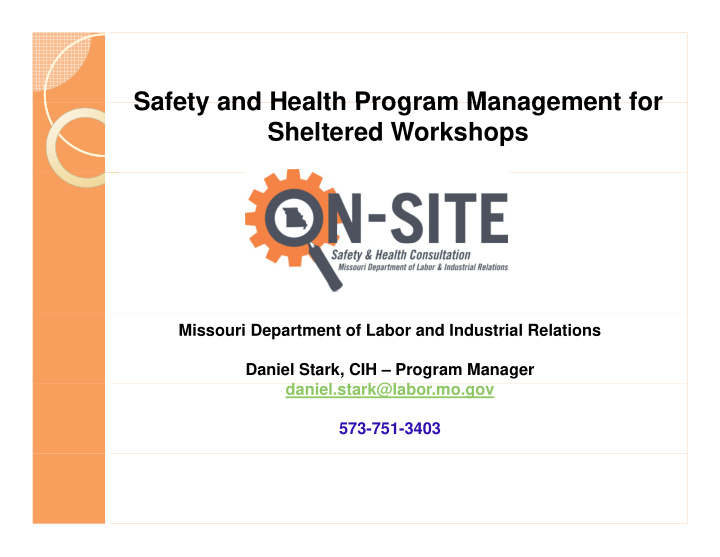



Fire Prevention Plan (29 CFR 1910 39) (29 CFR 1910.39) Procedures to control 5. flammable/combustible waste materials (housekeeping) (housekeeping) Maintenance procedures for 6. heat-producing equipment POC f POCs for equipment i t 7. maintenance and fuel hazards 42
Personal Protective Equipment (29 CFR 1910 132) (29 CFR 1910.132) 1. Hazard Assessment 2. Written Certification 3. Employee Training a) When PPE is necessary ) Wh PPE i b) What PPE is necessary c) c) How to properly don doff adjust and wear PPE How to properly don, doff, adjust and wear PPE d) Limitations of PPE e) Proper care, maintenance, useful life and di disposal l
Hazard Communication (29 CFR 1910.1200) Inventory/list of hazardous Inventory/list of hazardous 1 1. materials SDS for each hazardous 2. material SDS available on all shifts 3. Every private sector employer, regardless of size, must comply with HAZCOM! 44
Hazard Communication (continued) Hazard Communication (continued) Labeling - primary 4. and secondary containers Independent 5. contractors Non-routine tasks 6. Employee Training 7. 45
Major revisions to the Hazard Communication Standard Communication Standard Hazard classification : Provides specific criteria for 1. classification of health and physical hazards, as well as p y classification of mixtures. Labels : Chemical manufacturers and importers will be 2. required to provide a label that includes a harmonized signal required to provide a label that includes a harmonized signal word, pictogram, and hazard statement for each hazard class and category. Precautionary statements must also be provided. Safety Data Sheets : Will now have a specified 16- 3. section format. Information and training : The Revised HCS requires Information and training : The Revised HCS requires 4 4. that workers be trained by December 1, 2013 to facilitate recognition and understanding of the new labels and safety data sheets.
GHS Pictograms Explosive Flammable Oxidizer Compressed Gas ! Acute T oxicity y Corrosive Chronic Health Irritant Hazard
Dates To Remember � Employers by December 1, 2013: ◦ Initial employee training on pictograms, hazard I iti l l t i i i t h d statements and signal words ◦ Minimal training on new SDS format Minimal training on new SDS format � Employers by June 1, 2015: ◦ Continue to maintain the updated SDSs
Lockout/Tagout Program (29 CFR 1910.147) � Energy Control Procedure—protects employees who: ◦ Perform maintenance ◦ Perform maintenance ◦ Operate machinery � Excluded Operations: ◦ Cord/Plug equipment (if plug is controlled) 49
Lockout/Tagout Program (29 CFR 1910.147) (29 CFR 1910 147) Written Energy Control Program Locks or Tags acceptable 1. a) Durable b) b) Standardized St d di d c) Substantial Written start-up/shut-down procedures 2. for: a) Hard-wired machines b) Two or more sources of energy 50
Lockout/Tagout Program (29 CFR 1910.147) Periodic Inspections of 3. Lockout/Tagout Procedures ◦ At least annually ◦ Employer must certify (machine, E l t tif ( hi date, employee observed, inspector name) Authorized/Affected Employee 4. Training T i i ◦ Must ensure employee has knowledge and skills knowledge and skills ◦ Retraining Requirements 51
Bloodborne Pathogen Program (29 CFR 1910.1030) Applies if employees have � exposure to blood or other exposure to blood or other infectious materials Exposure Control Plan � Universal Precautions � Hepatitis B Vaccinations Hepatitis B Vaccinations � Communication of Hazards to � Employees Training � NOTE: “Good Samaritan” acts are not considered occupational exposure!
Respiratory Protection Program (29 CFR 1910 134) (29 CFR 1910.134) � Voluntary Use Voluntary Use � Procedures for � Procedures for selection � Medical Evaluations � Fit Testing Fi T i
Respiratory Protection P Program (continued) ( ti d) � Cleaning, disinfecting and storage � Training � Evaluation of program program effectiveness
Hearing Conservation Program (29 CFR 1910 95) (29 CFR 1910.95) � Required above 85 dBA for 8 hours � Monitoring Program � Audiometric testing � Training
Other OSHA Programs Other OSHA Programs Depending upon your process, you might also need: � Forklift Operators Training Program � Confined Space Program C fi d S P � Fall Protection Program � Fall Protection Program � Mechanical Power Press Program g � Electrical Worker Training
Self-Inspection Programs
Why do we need a Self- Inspection Program? I ti P ? � More safe and healthful workplace � Consistent removal of hazards from the workplace C i t t l f h d f th k l � Increased productivity � Increased productivity � Better employee morale p y � OSHA Compliance
Inspection programs by themselves will not work! – Why? t k! Wh ? For example: How does this hazard involve the “breakdown” of the four elements of safety the four elements of safety and health program management?
Keep in mind…… Keep in mind…… � Inspections are not the Safety Manager’s responsibility � Everybody is an inspector � Safety committees vs. no safety committees
Self-Inspection Checklist ( (OSHA’s Handbook for Small Business pub. #2209) p ) Covers the following: � Posting and Recordkeeping Welding, Cutting and Brazing � � Safety and Health Program Compressed air � � Medical Services and First Aid Compressed Gas Cylinders � � Fire Protection e o ec o Hoists o s s � � PPE Forklifts � � General Work Environment Spraying Operations � � Walkways Confined Spaces � � Floor and Wall Openings � Floor and Wall Openings Environmental Controls Environmental Controls � � � Stairs and Stairways Flammable and � Combustibles � Elevated Surfaces Chemical Exposures � � Exiting or Egress Hazcom Hazcom � � Ladders Ladders Electrical � � Tools Noise � � Machine Guarding Material Handling � � LOTO Ventilation Ventilation � �
How about some pictures of How about some pictures of hazards? � NOTE: This presentation does not include all hazards possible in a facility.
Recommend
More recommend